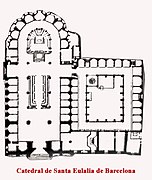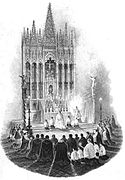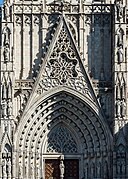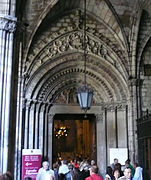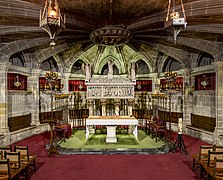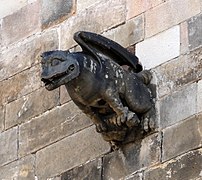Barcelona Cathedral
| Barcelona Cathedral | |
|---|---|
| Metropolitan Cathedral Basilica of the Holy Cross and Saint Eulalia | |
| |
 West façade in 2019. | |
 | |
| 41°23′02″N 2°10′35″E / 41.38389°N 2.17639°E | |
| Location | Barcelona |
| Address | Pla de la Seu |
| Country | Spain |
| Denomination | Catholic |
| Website | catedralbcn |
| History | |
| Status | Metropolitan Cathedral Basilica |
| Dedication | Holy Cross and Saint Eulalia |
| Dedicated | 18 November 1058[a] |
| Architecture | |
| Architect(s) | Jaume Fabre (first known) |
| Style | Catalan Gothic, Gothic Revival |
| Groundbreaking | 1 May 1298 |
| Completed | 1913 (west façade and dome) |
| Specifications | |
| Length | 93 m (305 ft) |
| Width | 40 m (130 ft) |
| Nave height | 28 m (92 ft) |
| Dome height (outer) | 70 m (230 ft) |
| Dome height (inner) | 41 m (135 ft) |
| Tower height | 54 m (177 ft) |
| Administration | |
| Archdiocese | Barcelona |
| Clergy | |
| Archbishop | Juan José Omella |
| Auxiliary Bishop(s) | Javier Vilanova Pellisa, David Abadías Aurín |
 | |
| Type | Non-movable |
| Criteria | Monument |
| Designated | 2 November 1929 |
| Reference no. | RI-51-0000338 |
The Cathedral of the Holy Cross and Saint Eulalia (Catalan: Catedral de la Santa Creu i Santa Eulàlia), also known as Barcelona Cathedral, is the Gothic cathedral and seat of the Archbishop of Barcelona, Catalonia, Spain.[2] The cathedral was constructed from the thirteenth to fifteenth centuries, with the principal work done in the fourteenth century. The cloister, which encloses the Well of the Geese (Font de les Oques), was completed in 1448.[3] In the late nineteenth century, the neo-Gothic façade was constructed over the nondescript exterior that was common to Catalan churches.[4]
Its form is pseudo-basilica, vaulted over five aisles, the outer two divided into chapels. The transept is truncated. The east end is a chevet of nine radiating chapels connected by an ambulatory. The high altar is raised, allowing a clear view into the crypt.
The cathedral is dedicated to Eulalia of Barcelona, co-patron saint of Barcelona, a young virgin who, according to Catholic tradition, suffered martyrdom during Roman times in the city. One story says that she was exposed naked in the public square and a miraculous snowfall in mid-spring covered her nudity. The enraged Romans put her into a barrel with knives stuck into it and rolled it down a street (according to tradition, the one now called Baixada de Santa Eulàlia). The body of Saint Eulalia is entombed in the cathedral's crypt.
The choir stalls retain the coats-of-arms of the knights of the Order of the Golden Fleece. In his first trip into Spain, Charles, the future Holy Roman Emperor, selected Barcelona as the site of a chapter of his Order. The king had arrived for his investiture as Count of Barcelona, and the city, as a Mediterranean port, offered the closest communication with other far-flung Habsburg dominions, while the large proportions of the cathedral would accommodate required grand ceremonies. In 1518 the Order's herald, Thomas Isaac, and its treasurer, Jean Micault, were commissioned to prepare the sanctuary for the first sitting of the chapter in 1519. Juan de Borgonya executed the painted decoration of the sanctuary.
The side Chapel of the Holy Sacrament and of the Holy Christ of Lepanto contains a cross said to date from the time of the Battle of Lepanto (1571).[5]
In addition to Saints Eulàlia and Olegarius, the cathedral contains the tombs of Saint Raymond of Penyafort, Count Ramon Berenguer I and his third wife Almodis de la Marche, and bishops Berenguer de Palou II, Salvador Casañas y Pagés, and Arnau de Gurb, who is buried in the Chapel of Santa Llúcia, which he had constructed.
The cathedral has a secluded Gothic cloister where 13 white geese are kept, the number explained by the assertion that Eulalia was 13 when she was martyred.[5]
History[edit]
Parts of an early Christian and Visigothic episcopal complex including the baptistery (fourth century), a basilical hall (fifth century), a cross shaped church (sixth-seventh century) and bishop's palace (sixth-seventh century) are displayed in Barcelona City History Museum archaeological underground. Reportedly, this Visigothic chapel was dedicated to Saint James, and was the proprietary church of the Viscounts of Barcelona.[6] However, in a document from the Second Council of Barcelona in 599, it states that the cathedral was dedicated to the Holy Cross.[3] This church was severely damaged by al-Mansur (Almanzor) during his attack on Barcelona in 985.
In 1046, Count Ramon Berenguer I and his wife Almodis, together with Bishop Guislabert, began construction of a Romanesque cathedral at the site; it was consecrated in November 1058.[3] The cathedral was constructed over the crypt of the former church. It has been reported that a Viscount of Barcelona, Mir Geribert, sold the site to Bishop Guislebert in 1058,[6] though however, this date does not coincide with the reported start of construction.
The present Gothic cathedral was begun on the foundations of the previous churches on 1 May 1298; James II the Just was King of Aragon at the time, and Bernat Pelegri was Bishop of Barcelona. The church was built from the east end towards the west end, with a simple west façade completed in 1417. The cloister was completed in 1448, making the total duration of construction 150 years. In the late nineteenth century, Miguel Girona i Agrafel offered to complete the neo-Gothic façade and central tower as inspired by the original fifteenth-century design prepared by master Carlí and rearranged and drawn by the architect Josep O. Mestres. This work was completed in 1913 by Girona's children.[3]
-
The façade in year 1850 by Jenaro Pérez Villaamil, published in the work España artística y monumental.
-
The reform of the façade at the commencement of the build in 1890.
-
The façade with the lateral towers, around 1900.
Chapel of Lepanto[edit]

The Chapel of the Holy Sacrament and of the Holy Christ of Lepanto is a small side chapel constructed by Arnau Bargués in 1407, as the chapterhouse. It was rebuilt in the seventeenth century to house the tomb of San Olegarius, Bishop of Barcelona, and Archbishop of Tarragona.
The "Holy Christ of Lepanto" crucifix, is located on the upper part of the chapel entrance's front façade. The curved shape of the body, of Our Lord Jesus Christ on the Cross, is explained by a Catalan legend which holds that the cross was carried on the prow of the galley captained by Juan of Austria, step-brother of Spanish Philip II of Spain during the Battle of Lepanto in 1571. When a cannonball flew toward the cross, it leaned out of the way in order to avoid being hit, and has been inclined ever since.[7] The Habsburgs were said to have regarded this as an encouraging omen.
A separate story says that the cross was in the ship's hold and that the figure moved to cover a large hole that would have sunk the ship.[8]
Architecture[edit]
The architectural design of the Barcelona Cathedral consist of the regional style of Catalan Gothic. Catalan Gothic construction is confined to the Barcelona area and its influences.[9] Catalan Gothic constructing consist of diaphanous areas and large spanning naves. Catalan Gothic does not seek to create towering buildings but to balance the dimensions of the structure.[10] The Barcelona Cathedral is 93 meters (305.1 feet) long, 40 meters (131.2 feet) wide, and 28 meters (91.8 feet) high at the central nave. Each bell tower of the cathedral is 54 meters (177.1 feet) in height. The tallest point of the cathedral reaches 70 meters (229.6 feet) tall at the peak of the cimborio.[9] The cathedral consist of three naves, one choir, and a cloister. The nave carries through the plan to the choir and the isle naves are at disproportioned heights to structurally support the central nave and the cimborio. Each aisle has two chapels in each section. The choir consist of 10 ogive (pointed) arches whereas ribbed arches were placed in the nave.[11] Large windows are placed opening to the cloister to provide sunlight to the choir. A windowed gallery runs atop the chapels in the aisle of the nave to provide indirect light. The facade is consistent with neo-Gothic design elements. Ornament of the cathedral facade is known for sculptural gargoyles on the roof along with many other animals and mythical creatures.
Gothic Quarter[edit]
The Barcelona Cathedral is located in the cathedral neighborhood in the Gothic quarter of Barcelona. As a showing of Catalonian nationalism the mediaeval buildings of the Gothic quarter were restored from 1927 to 1970. Over 40 structures were remodeled in the gothic style to upgrade the area that became one of the most attractive part of the city. The 'Catalan house' was the building that shaped the rest of the Gothic quarter. Directly behind the cathedral, many buildings during the restoration of the neighborhood were demolished or renovated to harmonizes after the Catalan House. Rebuilding the gothic quarter around the rebuilt facade of the Barcelona Cathedral and the Catalan house gave the opportunity to embellish the city with its most important buildings. The transformation of the cathedral neighborhood gives Barcelona an historic image that creates a relationship between heritage and tourism.[12]
Traditions[edit]
- The tradition of the 'dancing egg' (supported by the jet of a fountain) is maintained on the day of Corpus Christi at the cathedral.
Present day[edit]
The cathedral has been updated in response to an increasing number of tourists. The cloister now contains a gift shop, the traditional candles normally lit at the shrines of saints have been replaced with electronic candles, and cellular phones have been banned from the Chapel of Lepanto and other chapels.[13]
Images[edit]
-
Cathedral plan
-
Illustration of the main altar (1839)
-
Main portal
-
Door in the cloister
-
Chapel of Lady of the Rosebush
-
Santa Eulàlia's Crypt
-
Cloister
-
Geese in the cloister
-
Choir seats at the Cathedral
-
The Fountain in the Atrium of the Santa Eulàlia
-
The Cathedral garden
-
Gargoyle
-
Tomb of Saint Raymond of Penyafort
-
Scale model of the cathedral, at the Catalunya en Miniatura park
-
Bell Tower with stair turret above the door of Saint Ivo.
-
Barcelona Cathedral at night
See also[edit]
References[edit]
- ^ "962 aniversari de la Dedicació de la Catedral de Barcelona" [962th Anniversary of the Dedication of Barcelona Cathedral]. Església Arxidiocesana de Barcelona (in Catalan). 19 November 2020. Retrieved 15 June 2021.
- ^ Though sometimes inaccurately so-called, the famous Sagrada Família is not a cathedral
- ^ a b c d "Home". catedralbcn.org.
- ^ Edward Steese, "The Great Churches of Catalonia" Parnassus 7.3 (March, 1935:9-12) p. 9.
- ^ a b Patterson, Margot (1 April 2004). "To build a cathedral is immense, crazy work". National Catholic Register. Retrieved 12 January 2007.
- ^ a b F. Carreras Candi La Ciutat de Barcelona
- ^ This is said to have inspired the Habsburg forces to victory.O'Shea, Henry. A Guide to Spain, London, Spottiswoode and Co., 1865
- ^ "Holy Christ of Lepanto", Catedral de Barcelona
- ^ a b "Building". Catedral de Barcelona. Retrieved 2 December 2023.
- ^ Roca Fabregat, P.; Pellegrini, L.; Onate Ibanez de Navarra, E.; Hanganu, D.A. (1998). "Analysis of the structure of Gothic cathedral: Application to Barcelona Cathedral". upcommons.upc.edu.
- ^ "Barcelona Cathedral". Grove Art Online. doi:10.1093/oao/9781884446054.013.90000369760. Retrieved 2 December 2023.
- ^ Gant, Agustín Cócola (2 January 2014). "The invention of the Barcelona Gothic Quarter". Journal of Heritage Tourism. 9 (1): 18–34. doi:10.1080/1743873X.2013.815760. ISSN 1743-873X.
- ^ Administrator. "Catedral de Barcelona". www.catedralbcn.org. Retrieved 22 July 2016.
Notes[edit]
External links[edit]
- 14th-century Roman Catholic church buildings in Spain
- Roman Catholic churches completed in 1417
- Gothic architecture in Barcelona
- Roman Catholic cathedrals in Catalonia
- Tourist attractions in Barcelona
- Ciutat Vella
- Basilica churches in Spain
- Roman Catholic churches in Barcelona
- Burial sites of the House of Barcelona




